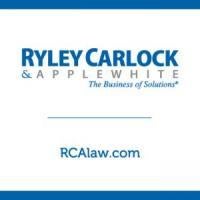The following information accompany a presentation Mike gave to members of the Arizona Commercial Lenders Association (ACMLA) on April 14, 2015, updating the group on recent legislative and case law developments regarding Arizona's anti-deficiency laws.
A.R.S. Section 33-814 Before and After January 1, 2015
Deadline for seeking deficiency. Section 33-814(A) of the Arizona Revised Statutes allows a foreclosing creditor (the "beneficiary"), within 90 days after the date of a trustee's sale, to commence an action to recover a deficiency against any person directly, indirectly or contingently liable [this includes borrowers, guarantors, general partners, etc.] on the underlying note or other contract that the Deed of Trust secured. If no action is commenced for a deficiency judgment within that 90-day period, Section 33-814(D) provides that the proceeds of the trustee's sale are considered to be in full satisfaction of the secured obligation and no right to recover a deficiency exists.
Amount of deficiency and fair market value credit. Section 33-814(A) provides that the amount of the deficiency judgment will equal the total amount owed to the beneficiary as of the date of trustee's sale, less the higher of (a) the sale price at the trustee's sale, or (b) the fair market value of the trust property on the date of the sale as determined by the court. For the foregoing purpose,"fair market value" means the most probable price, as of the date of the trustee's sale, in cash or in terms equivalent to cash, or in other precisely revealed terms, after deduction of prior liens and encumbrances with interest to the date of sale, for which the real property would sell after reasonable exposure in the market under conditions requisite to fair sale, with the buyer and seller each acting prudently, knowledgably and for self-interest, and assuming that neither is under duress.
Other obligors. Section 33-814(C) allows a foreclosing creditor to sue an obligor that isnot the trustor under (i.e., the party who signed) the Deed of Trust, regardless of whether a trustee's sale is held. However, if a trustee's sale is held, the non-trustor obligor must be sued within the 90-day period described above and gets the benefit of the fair market value credit described above.
"Anti-Deficiency" Property (this part changed effective January 1, 2015)
For deeds of trust originated before 2015, if trust property of 2-1/2 acres or less which is limited to and utilized for either a single one-family or a single two-family dwelling is sold at a trustee's sale, the foreclosing creditor cannot recover a deficiency.
For deeds of trust originated after 2014, the following types of property are expressly removed from the above anti-deficiency property category [see A.R.S. § 33-814(H)]:
-
Trust property owned by a person who is engaged in the business of constructing and selling dwellings that was acquired by the person in the course of that business and that is subject to a deed of trust given to secure the loan for construction of a dwelling on the property for sale to another person. [This addresses homebuilders.]
-
Trust property that contains a dwelling that was never substantially completed. For the foregoing purpose, a dwelling is substantially completed if (a) final inspection is completed, if required by the governmental body that issued the building permit for the dwelling, or (b) if a final inspection is not required by the governmental body that issued the building permit, the dwelling has been completed in all material respects as prescribed in the applicable ordinances and regulations of the governmental body that issued the building permit for the dwelling.
-
Trust property that contains a dwelling that is intended to be utilized as a dwelling but that is never actually utilized as a dwelling.
General Rules: When Can You Pursue a Deficiency Judgment?
-
If you have a purchase money loan secured by an anti-deficiency property, no deficiency judgment is allowed, regardless of whether you foreclose judicially or by trustee's sale.
A purchase money mortgage is one that secures the payment of the balance of the purchase price, or secures a loan to pay all or part of the purchase price, of an anti-deficiency property. Under the Helvetica case described below, a construction loan is considered a purchase money loan if (i) the loan proceeds are used to build a dwelling protected by the anti-deficiency statute, (ii) the deed of trust securing the loan covers the land and the dwelling constructed on the land, and (iii) the loan proceeds were in fact used to construct the residence. The Helvetica case also permitted the lender to seek a deficiency judgment for the non-purchase money portion of a mortgage loan (for example, in a "cash out" refinancing of a purchase money loan) by judicially foreclosing.
-
If you complete a trustee's sale on an anti-deficiency property, no deficiency judgment is allowed, regardless of whether your loan is a purchase money or non-purchase money loan.
-
If you have a non-purchase money loan secured by an anti-deficiency property, (1) no deficiency judgment is allowed following a trustee's sale, but (2) a deficiency is allowed if you conduct a judicial foreclosure.
If a lender holds a junior non-purchase money deed of trust on an anti-deficiency property and a senior lienholder completes a trustee's sale of its lien to extinguish the junior lien, the former junior lienholder can recover a deficiency on the now unsecured junior obligation, even if the same lienholder held both the junior and senior deeds of trust. [See Wells Fargo Bank v. Riggio(Arizona Court of Appeals 2013).] (Technically, the former junior lienholder's action is not a deficiency action because it did not complete its trustee's sale (nor is it subject to the 90-day bar date that would apply to a deficiency action following a trustee's sale).)
Some Key Arizona Deficiency Cases
Northern Arizona Properties v. Pinetop Properties Group (1986). The Arizona Court of Appeals held that a property (a condominium held for investment purposes that was not permanently occupied) qualified as a "dwelling" for anti-deficiency purposes as long as the structure was lived in or occasionally occupied by some person.
Baker v. Gardner (1988). The Arizona Supreme Court held that, if a lender's loan is a purchase money loan secured by anti-deficiency property, the lender cannot waive its security and sue on the note. However, if the lender's loan is a non-purchase moneyloan (such as a HELOC) that is secured by an anti-deficiency property, the lender can waive its security and sue on the note.
Cely v. DeConcini, McDonald (1990). The Arizona Court of Appeals held that a non-purchase money mortgage does not become a purchase money mortgage when it is assumed as part of the sales price by a later purchaser.
Mid Kansas v. Dynamic Development Corp. (1991). The Arizona Supreme Court extended anti-deficiency protection to a residential developer that defaulted on two construction loans. The Court held that: (a) a homebuilder is entitled to anti-deficiency protection as long as the collateral fits within the statutory definition of a "dwelling" (i.e., whether the trustor is a homeowner or developer is irrelevant); but (b) an unfinished property that was not used as a dwelling, had never been lived in, and was being held for sale to its first occupant by an owner who had no intent to ever occupy the property did not qualify the dwelling for anti-deficiency protection.
Bank One Arizona v. Beauvais (1997). This case addressed whether a purchase money loan retains its purchase money character after being refinanced by the same lender. The borrowers obtained a loan from the bank to exercise stock options, pledging the stock as collateral. They then obtained another loan from the same bank to purchase a home. The new loan consolidated the stock option loan and the home purchase loan into a single note, and the consolidated loan proceeds paid off the first loan and funded the purchase of the home. The consolidated loan was secured by the stock and a deed of trust. The borrowers later signed a new "workout note" secured by the stock and the existing deed of trust. When the borrowers defaulted, the bank argued that the workout note was not a purchase money obligation, but a new and independent loan or, alternatively, that it should be able to recover the pro rata portion of the workout note that was non-purchase money in nature. The Arizona Court of Appeals held that the note retained its purchase money character after having been extended, renewed and refinanced and the deed of trust on the property that was bought with the original loan was continued or renewed. The Court of Appeals did not address the segregation of the non-purchase money portions of the loan, as the bank had abandoned its argument that such funds should be traced and included in a deficiency judgment.
Marshall & Ilsey Bank v. Mueller (2011). The Arizona Court of Appeals extended the anti-deficiency statutes to protect borrowers from a deficiency judgment after a foreclosure of a mortgage against their unfinished house. Several months into construction, the borrowers discovered that their contractor was behind schedule and that much of the construction that had been completed was defective. The borrowers requested loan advances to cure the construction defects, which the bank declined to advance. The borrowers later abandoned the property without completing the residence and defaulted under the loan. The bank contended that, because the home was never completed and never occupied, it did not qualify as anti-deficiency property. However, the Court of Appeals protected the borrowers from a deficiency judgment based on their professed intent to occupy the dwelling upon its completion, even though the house was never completed and had never been lived in. The Arizona Supreme Court denied review of the Court of Appeals decision.
Helvetica Servicing, Inc. v. Pasquan (2012). This case addressed a situation where the borrowers had obtained a loan (secured by a first deed of trust) to purchase a home, and later obtained a second loan from a new lender. The proceeds of the second loan were used to pay off the first loan and to demolish the home on the property and build a new home. The borrowers then obtained a third loan from Helvetica, the proceeds of which were used in part to pay off the second lender's loans. The borrowers defaulted and Helvetica filed a judicial foreclosure action. The Arizona Court of Appeals held that refinancing a purchase money loan does notdestroy purchase money status and eviscerate anti-deficiency protection to the extent proceeds from there financing are used to satisfy the underlying purchase money obligation, but allowed Helvetica to pursue a deficiency judgment for any non-purchase money loan proceeds to the extent that those proceeds can be segregated and traced. Note that this ruling dealt with a case where a lender judicially foreclosed upon the property (had the lender instead completed a trustee's sale, it would not have been entitled to seek a deficiency judgment, regardless of whether the refinanced loan proceeds were purchase money or non-purchase money debt). The Court of Appeals also ruled that a construction loan qualifies as a purchase money loan if the loan proceeds are actually used to construct the home that otherwise qualifies for anti-deficiency protection, and if the deed of trust securing the loan encumbers that land and the house built on the land.
Independent Mortgage Company v. Alaburda (2012). The Arizona Court of Appeals held that the owners of a one-tenth fractional interest in a vacation home (which entitled them to use the property for a maximum of 28 days per year) qualified as anti-deficiency property.
CSA 13-101 Loop v. Loop 101 (2014). This case dealt with whether an obligor under a commercial real estate loan can waive its right to a fair market value hearing. The lender's loan documents provided that the obligors agreed for deficiency purposes that the fair market value of the property would equal the sale price at the trustee's sale. The bank completed a trustee's sale of a commercial office building and then sued the obligors for a deficiency. The Arizona Supreme Court held that an obligor cannot waive its right to such a hearing in advance.
BMO Harris Bank v. Wildwood Creek Ranch (2015). The Arizona Supreme Court effectively overruled the Mueller decision (see above) by holding that anti-deficiency protection is not available unless and until a dwelling is completed on a property. The borrower and its principals had borrowed money against a vacant lot. No construction of any kind was started or completed on the parcel before it was sold at a trustee's sale. The guarantors/principals contended that they were not liable for the deficiency because they intended to build a single one-family dwelling on the lot.
Practice Pointers
- Include appropriate recitals in your loan documents to take your loan outside of the anti-deficiency rules. For example, if the residential-looking collateral is more than 2.5 acres or not intended for use as a single one-family or a single two-family dwelling, or if the property is being constructed by a homebuilder, have the borrower and guarantors acknowledge in the loan documents that such is the case and that the anti-deficiency rules are not applicable.
Bear in mind that the new exclusions in A.R.S. § 33-814(H) apply only to deeds of trust originated after 2014. Therefore, deeds of trust originated before 2015 remain subject to the old statute and the court decisions interpreting the old statute. While Mueller and its "intent" test have now been laid to rest, other provisions of pre-2015 law continue to apply (such as the extension of anti-deficiency protections to homebuilders), and should be taken into consideration in modifying or enforcing pre-2015 loans. In connection with homebuilder loan modifications, some thought should be given to using new deeds of trust to take advantage of the homebuilder exclusion from the new statute (future case law is likely to tell us whether this approach will be effective).
- Avoid unnecessarily creating anti-deficiency properties. For example, if your intended collateral from a given borrower (or perhaps a borrower and certain affiliates) consists of multiple residential properties in the same county, consider encumbering them with a single deed of trust (so that your trust property is not a single one-family or a single two-family dwelling). Be aware that releasing residential units from a blanket deed of trust could eventually leave you with a single anti-deficiency property.
- If a new loan is being used to consolidate and refinance both purchase money and non-purchase money loans, recite appropriate details regarding the underlying non-purchase money amounts being consolidated or refinanced so that proceeds can be traced for deficiency purposes. Also consider providing in the consolidated loan documents that the purchase money component of the consolidated debt will be considered to have been repaid before the non-purchase money component.




 />i
/>i
